Best Orthotics for Children with Low Muscle Tone – Let’s Stabilize Your Child’s Feet!

Has your child been diagnosed with low muscle tone (hypotonia) and your medical professional recommended that you fit a pair of orthotics to be fitted inside the shoes? Have you noticed that your child’s feet are not in alignment, and this is affecting your child’s foot posture and walking gait? Early intervention with orthotics and supportive footwear can help mitigate these issues by providing the necessary support to the feet and lower extremities during the critical developmental years.
Does Your Child Have Flat Feet?
Most low-tone children fall into pronation. I have noticed that children with low muscle tone tend to have flat feet, and children with flat feet tend to have poor balance and coordination. Don’t worry too much if your child is not walking yet. Children with low tone tend to walk late because their feet are in poor alignment and their toes curl under for stability, making their feet tire faster.
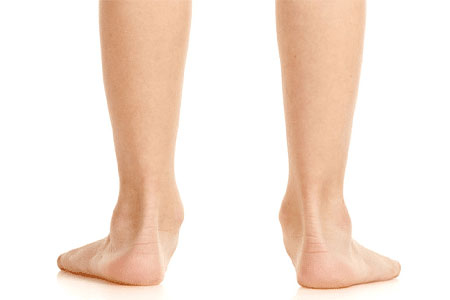
The Role of Orthotics
For children with low muscle tone, orthotics can help stabilize their gait, enhance balance, and encourage proper foot development. By providing additional support, orthotics can also reduce the risk of injury and fatigue, enabling children to participate more fully in physical activities.
What Are Good Orthotics for Children with Low Muscle Tone?
There are several orthotics out there so it can be challenging for parents to decide which ones are best for their children. I have tested different orthotics and I know which ones are more effective than others from observing the child stand and walk with them. There is one specific orthotic that provides similar benefits as custom orthotics but at a more affordable price.
The Impact of My Orthotic Recommendations: Before and After
Most parents make the common mistake of assuming that the orthotics only support the arch of the foot. Orthotics should not only support the arch, but they should also mechanically support all of the pieces of the foot that cause the feet to collapse such as the heels.

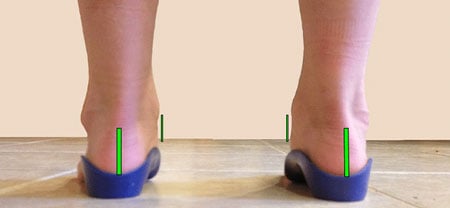
Notice how the deep heel cup stabilizes the heel in a midline position. This will help improve the child’s stability.
How Soon Should Children Wear Orthotics?
This is quite a complex subject in which some medical professionals recommend early intervention while others recommend waiting until the child is five years old or older. In my experience it should not be a matter of age, it should be a matter of whether we can help improve the child’s stance and overall posture.
I speak to families of children with low muscle tone on a weekly basis, and most of them regret not having acted sooner. These families are frustrated and infuriated as their medical professionals tell them “Don’t worry, your child will outgrow it soon”. I strongly suggest families not play the “waiting game” when it comes to treating their children’s foot conditions. Waiting for your child’s foot condition to “magically disappear” might only lead to the condition getting worse.
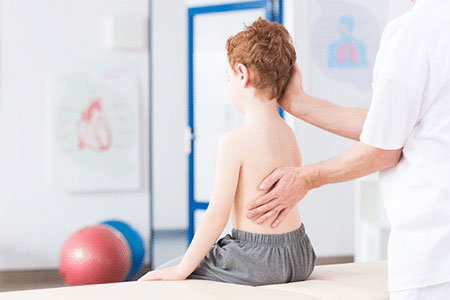
The Complications of Leaving Your Child’s Low Muscle Tone Untreated
When your child’s feet are not in alignment, your child’s knees and hips also become misaligned. This means the muscles that move those joints no longer work efficiently, and it will take more energy for your child to do the same work as other children who don’t have this condition. Muscle fatigue and stiff leg muscles are common complaints of children who have persistent foot pronation.
Children between the ages of 1 and 5 are undergoing rapid neuromuscular development and foot pronation during these years can often be easily managed with proper foot orthotics and correct footwear. Unresolved foot conditions after age 5 or older, although still manageable, can become a bit more difficult to control.
What Makes These Orthotics Effective for Treating Low Muscle Tone?
The orthotics I recommend for children with low muscle tone are the least restrictive ones as they allow for the normal movement of the foot. One of the main reasons why this orthotic works so efficiently for children with low muscle tone is that it provides a deep heel cup (30mm to be more precise) that provides stability and improves the child’s walking gait.
Key Feature One: 30mm deep heel cup provides stability and helps maintain proper alignment of the foot, preventing excessive pronation or supination. By securely cupping the heel, this feature ensures that the foot remains in an optimal position, reducing the likelihood of strain and injury.
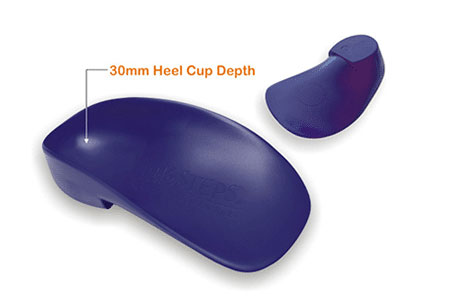
Key Feature Two: Medial and lateral flanges help keep the foot aligned over the orthotic. I have noticed how most children’s prefabricated orthotics lack this feature and the child’s foot pushes through the orthotic and does whatever it wants.

Best Orthotics for Low Muscle Tone to Improve Posture and Stability
The orthotic below is the best prefabricated on the market for helping treat and control low muscle tone. One of the main goals of this orthotic is to prevent your child’s balance be affected by their low muscle tone.
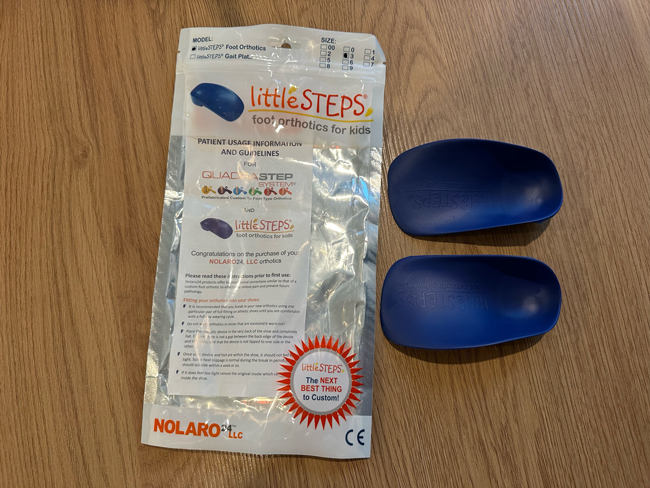
- Order littleSTEPS® Orthotics from their official website. You must submit a Referral Code to complete your order: JVFCS100121
- It’s not necessary to remove the original insoles of the shoes when fitting this orthotic.
- The 3/4 length design makes it easier to fit into various shoe styles.
- Take a look at this chart to figure out what size to order based on your child’s shoe size.
This orthotic can be shipped anywhere. Within the USA, shipping can take about 10-15 days depending on the location and the shipping method. Overseas shipping is available but will be more expensive.
Are the Orthotics I Recommend Better than AFOs and SMOs?
I believe they are better. I have fitted several children with SMOs and AFOs at the shoe store I work for, and I always found those orthoses devices too rigid, and I feel like they immobilize the foot. With that said, it’s a fact that SMOs and AFOs can be extremely effective in helping treat a child’s foot condition.
I am not saying that if your medical professional wants your child fitted in a pair of AFOs or SMOs you shouldn’t comply, I just prefer to always start with a less invasive orthotic and take it from there. A lot of children have a hard time getting used to wearing AFOs and SMOs. In addition, parents always have a hard time finding a good pair of shoes to fit the braces.
Choosing Supportive Shoes for Orthotics
Selecting the right shoes is just as important as choosing the right orthotics. Supportive shoes that fit orthotics well are crucial for maximizing the benefits of the inserts. Look for shoes with a firm heel counter, a wide toe box, and removable insoles to accommodate the orthotics. These features ensure that the shoe works in tandem with the orthotic to provide comprehensive support and stability.
Ensure that the shoes provide enough depth and width to prevent any pinching or discomfort. A proper fit is essential for comfort and effectiveness, allowing children to move freely without restriction.
Final Thoughts on Children with Low Muscle Tone
It’s quite clear that the correct type of orthotics can help optimize your child’s foot-joint alignment and weight-load distribution. Keep in mind that supportive shoes or orthotics won’t make your child’s muscles weaker. All you are doing is providing your child with structural support.
Certain orthotics can make a world of difference for a child with low muscle tone as they help capture the child’s heels into a more appropriate alignment for taking body weight while leaving the forefoot active and operative.
Your child’s walking gait determines how much energy your child uses with each step. If your child’s feet are not in alignment, your child will tire easily and likely become sedentary. Please take early action and prevent your child from gaining excessive weight, as it might become harder to get them active again.
“Low Muscle Tone And Your Child – What You Need To Know.” Surestep, 1 Dec. 2016, surestep.net/blog/low-muscle-tone-hypotonia-an-overview-for-parents/.
“Muscle Weakness (Hypotonia): Boston Children’s Hospital.” Boston Children’s Hospital,www.childrenshospital.org/conditions-and-treatments/conditions/m/muscle-weakness-hypotonia.

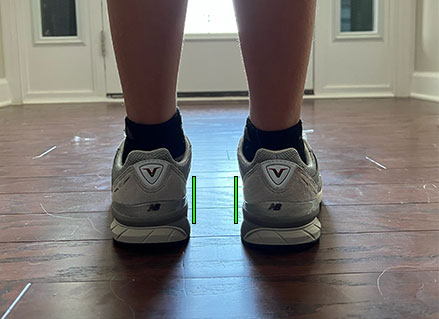
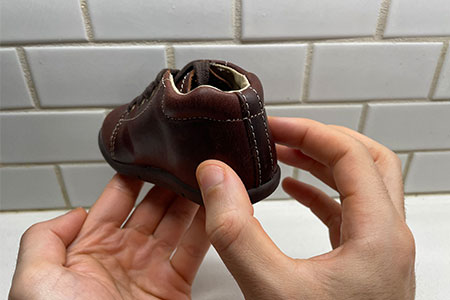

My nephew has low muscle tone and the PT recommended a pair of supportive shoes with his orthotics. Is there a specific style that you can recommend? He has extra extra wide feet and the orthotics can’t seem to fit in any of the shoes I buy. I am tired of wasting money in shoes that don’t work. Any suggestions will be greatly appreciated.
Hello Ann,
Sure, I am happy to help. The shoes I recommend in this article are available in different widths such as wide (W) and extra wide (XW). Make sure that you select the extra wide width (XW) when you choose your nephew’s shoe size. These shoes also provide extra depth which makes them ideal for orthotics.